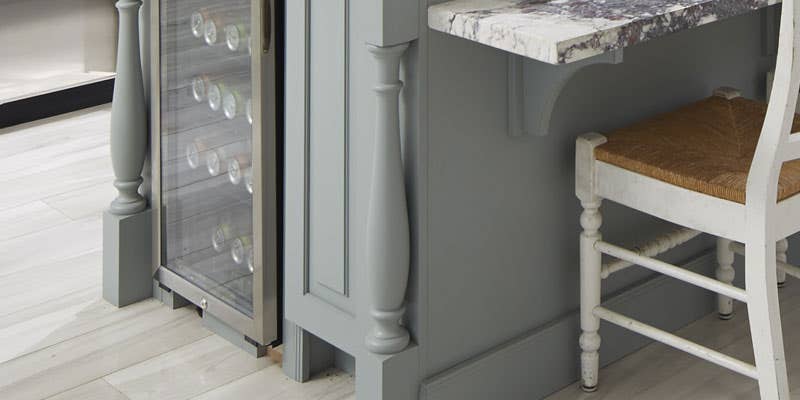Transform Your Kitchen's Look with Special Legs For Kitchen Island Devices
Transform Your Kitchen's Look with Special Legs For Kitchen Island Devices
Blog Article
Necessary Aspects to Take Into Consideration When Selecting Legs For Kitchen Area Island
Selecting the ideal legs for a cooking area island includes a careful assessment of numerous factors that can substantially influence both capability and aesthetic charm. Amongst these, the option of material plays a crucial duty in guaranteeing sturdiness, while the style needs to match the existing decoration. Factors to consider such as height and weight support are crucial for stability and convenience. As we explore these aspects, it ends up being clear that each decision can have far-reaching ramifications for the total kitchen area experience. What subtleties should be considered in each of these categories to accomplish the perfect balance?
Material Options
When selecting legs for a kitchen area island, comprehending the numerous material options is crucial for achieving both visual appeal and architectural stability (Legs For Kitchen Island). The selection of material considerably influences not only the sturdiness of the island yet additionally its overall design and performance
Metal legs, commonly made from stainless steel or functioned iron, add a commercial and contemporary feeling while making certain toughness and security. These products are resistant to put on and can sustain substantial weight, making them excellent for bigger islands.
One more alternative is engineered products, like MDF or plywood, which can be extra cost-effective while still offering a range of surfaces. However, they might not offer the exact same level of security as solid timber or metal. Products such as acrylic or glass can develop a contemporary look, though they might need extra support to make sure stability.
Ultimately, the option of product for kitchen area island legs ought to line up with the wanted capability and the general motif of the cooking area.
Design and Style

When taking into consideration design, the shape and surface of the legs are important. Conical legs can supply a sense of agility and elegance, while thicker, more robust legs can communicate strength and security. Furthermore, the finish-- be it repainted, discolored, or all-natural-- should enhance the kitchen cabinetry and kitchen counter materials to create a unified appearance.
Additionally, the style of the legs can also mirror personal taste. Custom-made or decorative legs, such as those including complex carvings or unique geometric forms, can function as centerpieces, including character and individuality to the kitchen area. Ultimately, the appropriate choice will certainly not only boost performance but additionally raise the aesthetic allure, making the kitchen area island a standout feature of the home.
Elevation Factors To Consider
Choosing the proper height for kitchen area island legs is additional reading crucial, as it straight influences both performance and convenience. The basic elevation for a kitchen island normally varies from 36 to 42 inches, lining up with usual countertop heights.

It is also necessary to make up individuals' heights and choices. Tailoring the height can ensure a comfy experience for all member of the family, making the kitchen area island a more functional and delightful area.
Weight Support
Making sure sufficient weight assistance for kitchen area island legs is vital for both safety and capability. The kitchen area island more helpful hints often offers multiple objectives, including food prep work, eating, and additional storage, necessitating a durable support structure. When picking legs, it is crucial to take into consideration the general weight ability required based upon the island's intended use and the products that will be put on it.
The selection of material for the legs plays a substantial role in their weight-bearing capacities. Solid wood, steel, and heavy-duty composites normally provide remarkable toughness compared to lighter materials. In addition, the layout of the legs-- whether they are straight, tapered, or have a pedestal type-- can affect their ability to browse around here distribute weight successfully throughout the structure.
Always seek advice from the maker's specs relating to tons limitations to make sure that the legs can maintain the designated weight without jeopardizing safety. In summary, selecting kitchen island legs with ample weight assistance is crucial for developing a functional and safe cooking room.
Setup and Maintenance
Appropriate installation and upkeep of kitchen island legs are crucial for ensuring durability and stability. This commonly involves safeguarding the legs to the island base utilizing ideal fasteners, making certain that the legs are level and straightened.
When mounted, regular upkeep is necessary to protect the integrity and appearance of the legs - Legs For Kitchen Island. For wood legs, periodic cleansing with a wet fabric and application of ideal wood polish can protect against dampness damage and preserve their coating. Metal legs may call for a gentle cleaning option to remove grease and gunk, followed by a dry fabric to avoid rust formation
In addition, examine the legs consistently for indications of wear or damages, such as cracks or loose joints. Tightening screws or bolts as needed can likewise extend the life expectancy of the legs. By sticking to these installment and upkeep techniques, homeowners can ensure that their kitchen island remains durable and visually appealing for years to come.
Final Thought

Aesthetic coherence is paramount in picking the design and design of legs for a cooking area island, as these aspects significantly affect the general ambiance of the area. Conical legs can give a feeling of lightness and elegance, while thicker, more robust legs can convey toughness and stability.Choosing the appropriate elevation for kitchen area island legs is vital, as it directly affects both capability and convenience. In summary, picking kitchen area island legs with sufficient weight assistance is necessary for creating a safe and useful cooking space.
In verdict, selecting legs for a kitchen island necessitates mindful factor to consider of various factors, consisting of material options, style, height, weight support, and setup.
Report this page